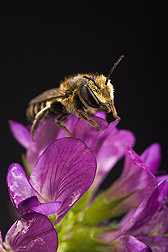Science Update
|
|
Making Homes To Please Wild Bees
While teams of researchers are investigating the disappearance of millions of honey bees that would otherwise have helped pollinate billions of dollars worth of U.S. specialty crops, others are working on ways to attract and support so-called wild bees. Nobody really knows how much pollinating work these unmanaged bees do as they go about their often-solitary lives, but estimates are that it’s considerable—and could be more.
Unlike the domesticated honey bee, which spends its life tending the complex hive in which generations of bees are hatched and nurtured, wild bees prefer to live in a quieter fashion. In nature, they’re drawn to dark, snug recesses or nesting cavities—sometimes dug into the earth or hollowed out of trees or wooden structures. To better ensure the pollinating services of wild bees in orchards and fields where they’re needed, researchers are experimenting with alluring aromas for use with artificial nest cavities. By studying the components of the bees’ natural nests—including old pollen, leaves, mud, and bee fluids used in constructing nest walls—researchers hope to learn how to manufacture housing for wild bees that will smell more like home.
Theresa L. Pitts-Singer, USDA-ARS Pollinating Insects Biology, Management, and Systematics Research Unit, Logan, Utah; phone (435) 797-0581.
Whether fresh, dried, or an essential oil, basil is a popular herb in the United States and around the world. With imports valued at about $5.6 million in 2000, the aromatic plant could find use as a high-value alternative crop for U.S. farmers.
In cooperation with Mississippi State University (MSU), researchers have been evaluating field performance and composition of 38 basil accessions obtained from ARS’s National Plant Germplasm Collection and grown at the MSU Research and Extension Center in Verona, Mississippi. The plants didn’t appear to be susceptible to insect pests that typically infest basil varieties grown in southeastern Europe, a significant center of basil production. The yields of dry basil obtained from all accessions were relatively high—most exceeding 3,500 pounds per acre—but they were found to contain a range of different essential oils. Other research showed that harvest practices altered essential oil content, yield, and composition.
Charles L. Cantrell, USDA-ARS Natural Products Utilization Research Unit, Oxford, Mississippi; phone (662) 915-5898.
New portable field kits for detecting antibiotics in the environment have been developed and validated. Unlike existing methods, they’re easy to use, require minimal training, and give quick results. The kits rely on ELISA—enzyme-linked immunosorbent assays—to detect trace amounts of sulfonamides, or “sulfa drugs,” in wastewater. Such monitoring would be helpful to operators of wastewater and sewage plants, while scientists or farmers might use the kits to monitor the fate and transport of sulfonamides in soils.
Developers think the kits are a flexible complement to the liquid chromatography-mass spectrometry instrumentation that was used to verify the kits’ accuracy. They could be especially useful for situations requiring routine environmental monitoring. Cooperating in the research were the Veterinary Research Institute in Brno, Czech Republic; and Abraxis, LLC, of Warminster, Pennsylvania.
Weilin L. Shelver, USDA-ARS Animal Metabolism-Agricultural Chemicals Research Unit, Fargo, North Dakota; phone (701) 239-1425.
Nitric Oxide Regulates Plant and Animal Signaling
A sometimes-toxic byproduct of nitrogen oxidation in soil, nitric oxide (NO) may have broader implications in plant processes than previously realized. Its modification of proteins through a process called “S-nitrosylation” is increasingly recognized as a ubiquitous regulatory reaction in both plants and mammals. In plants, NO inactivates rubisco, a major enzyme involved in carbon dioxide fixation and photosynthesis.
Recent findings came about from studying Kalanchoe pinnata, or miracle leaf, as a model plant; previous work looked at NO targets in the most common model plant, Arabidopsis. Targeted proteins and enzymes are involved in regulating processes ranging from seed germination and cell development to plant death, as well as sugar metabolism and tolerance to diseases and stress. Both model plants have some NO targets in common, but this study—conducted with professor Renu Deswal and a doctoral student in the Botany Department, University of Delhi, India—revealed new protein targets not previously reported.
Autar Mattoo, USDA-ARS Sustainable Agricultural Systems Laboratory, Beltsville, Maryland; phone (301) 504-6622.
"Science Update" was published in the September 2009 issue of Agricultural Research magazine.







